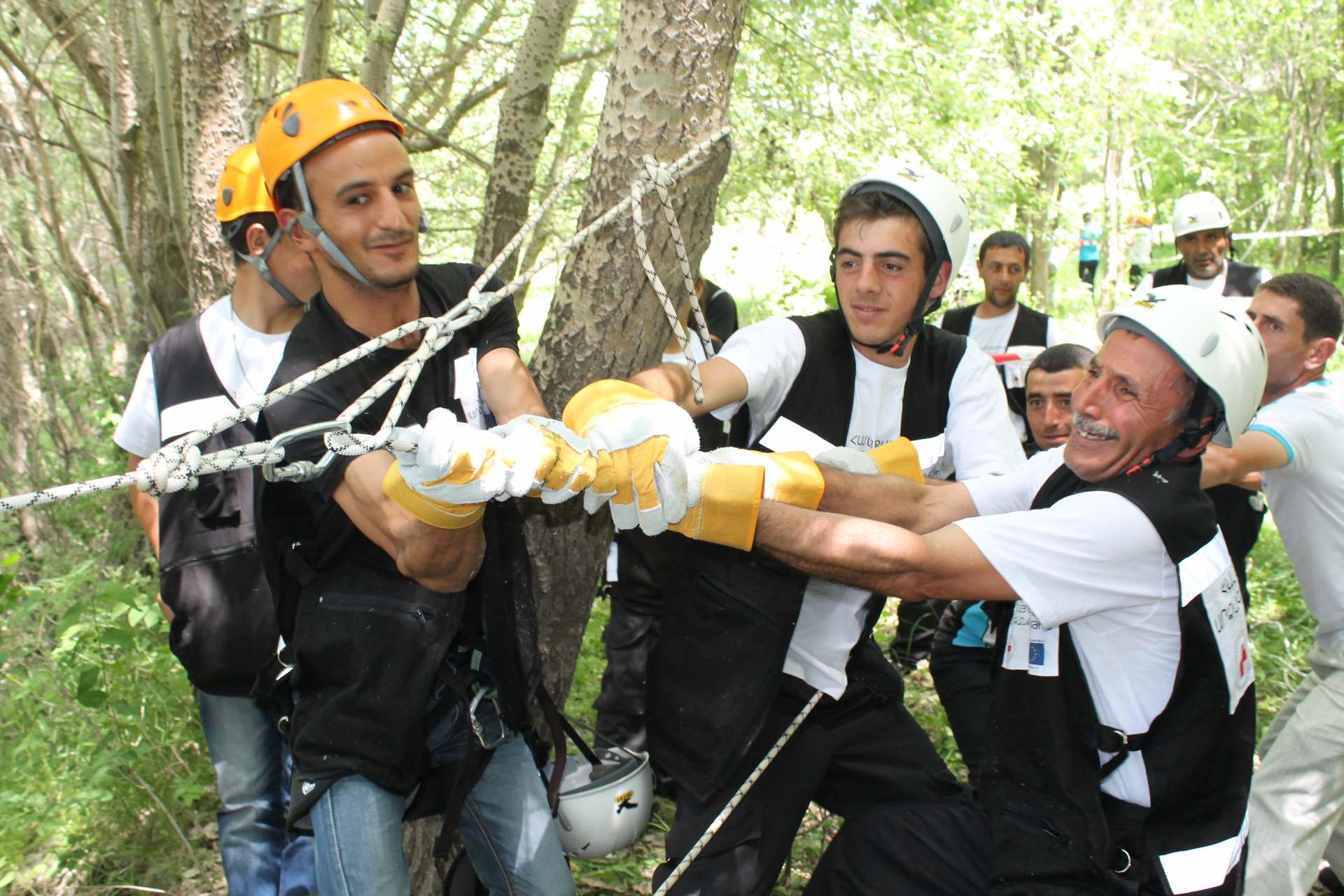
Armenian Red Cross Society implemented Second phase of “Building Safer Local Communities in South Caucasus” project from June 2012 to November 2013. The project is co-funded by The European Commission's Humanitarian aid and Civil Protection Directorate General, Danish, Austrian and Icelandic Red Cross. 14 communities, 65 schools and 88.780 people of Shirak region were selected as a target for the implementation of the project. Target communities were Arapi, Azatan, Sarnashbyur, Pemzashen, Anushavan, Shirak, Panik, Kaps, Mets Mantash, Qeti, Nor Kyanq, Mets Sepasar, Beniamin, Ategnadem.
Main objective of the project was to enhance resilience of targeted vulnerable communities in Armenia to plan/prepare, mitigate and respond to disasters through consolidation and validation of Armenian Red Cross Societies’ Community Based Disaster Risk Reduction model
Results of the project are:
1.The preparedness and response capacities of the previously targeted communities are consolidated and expanded to new/additional communities to enable the local population to better prepare for and respond to natural disasters
1.1.There were organised refresher/upgrade trainings for 9 existing and 5 new Community Volunteer Disaster Preparedness and Response Teams (CVDPRT) as Community Based First Responders.
1.2.Conducted 10 regional / municipality / community simulation exercises jointly with regional and local authorities, including Regional Rescue Services.
1.3.Updated / developed participatory disaster preparedness and response plans / Plan of Action in 9 existing and 5 new communities.
1.4.Updated / developed “Who does What, Where” (3X W) in the target regions
1.5.Updated / conducted participatory Vulnerability and Capacity Assessments in 9 existing and 5 new communities.
1.6.Organised peer-to-peer exchange of experience and support by already existing CVDPRT teams to newly established CVDPRT teams through field camp exercises and exchange visits between the teams and rescue services in the vicinity of their communities.
2.Target communities’ awareness on most prevalent local hazards and potential climate change impact has increased and community members know how to reduce the vulnerability of their households and the school environment to natural disasters.
2.1 Existing DRR Information, Communication and Education (ICE) materials on DRR were updated and consolidated.
2.2 Refresher/upgrade training was provided for 150 trained teachers and 80 new teachers from 65 schools.
2.3 Teachers were assisted in providing refresher/upgrade training for 14.930 students and train 7.040 new students in 65 schools through non-formal after school activities. A competition on local and regional level took place to determine the best Family Emergency Plans.
2.4 Workshops were organised on climate change adaptation / livelihood protection activities in 14 target communities
2.5 Local authorities and relevant ministries were assisted revising existing school evacuation plans and jointly conduct school evacuation exercises
3.The developed “Community Based Disaster Risk Reduction Model” was consolidated and institutionalized in the national framework of National Societies and key stakeholders.
3.1.Upgrade training were provided in psycho social support, communication in emergencies & dealing with media, climate change adaptation, camp management & recovery activities for Red Cross staff, volunteers and key stakeholders.
3.2.Small scale mitigation projects were implemented in the target locations jointly with local authorities and community members.
3.3.Quarterly roundtable meetings were organised with relevant stakeholders focusing on community based DM/DRR, promotion of HFA and development of recommendations for incorporation of DRR in regional and local development and/or annual plans in the target regions.
3.4.Workshops were organise to finalise and consolidate the “Community Based DRR Model” jointly with key stakeholders.
4.The public awareness on Disaster Risk Reduction and Climate Change adaptation was increased.
4.1.Information brochures, pamphlets and posters on Disaster Management topics were updated and distributed.
4.2.The National Societies Communication Strategy was developed / updated.
4.3.Publicity events were organised on the World DRR day.
5.South Caucasus cooperation was enhanced and lessons learned throughout the Action were documented and disseminated among key stakeholders at local, national, regional and international levels strengthening knowledge sharing.
5.1.Programme launch press conference was organised, midterm and final result / lessons learned conferences jointly with relevant DRR partners.
5.2.Consolidated and were shared “Best Practices & Lessons Learned” and the “Community Based DRR Model” with local, national, regional and international key stakeholders through roundtable meetings/Global conferences and exchange visits with RC/RC partners implementing DRR in other regions.
5.3.Quarterly Skype conferences were organise with consortium partners and other relevant Red Cross / Crescent stakeholders.
5.4.South Caucasus Steering Committee and Cooperation Meetings were organized, including CAC Regional Red Cross/Crescent Societies
5.5.Jointly with South Caucasus DIPECHO partners, regional lessons learned workshop was organised at the end of Action period.